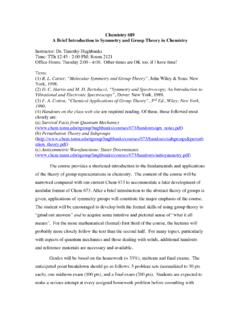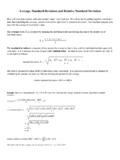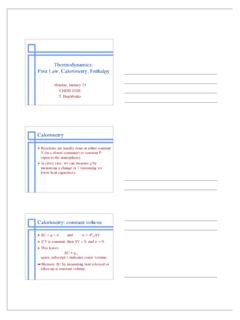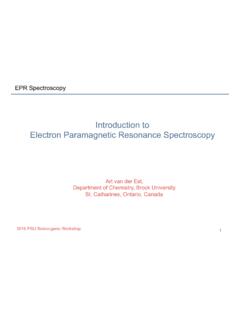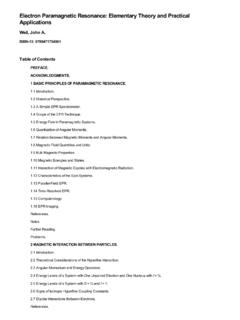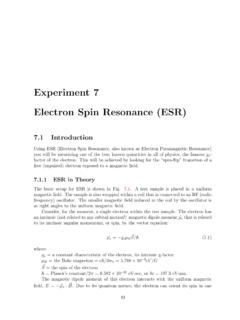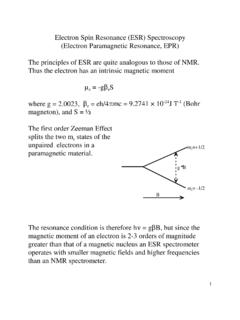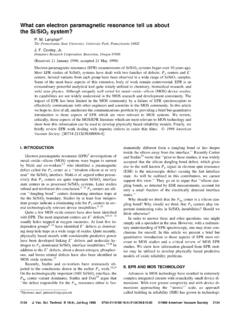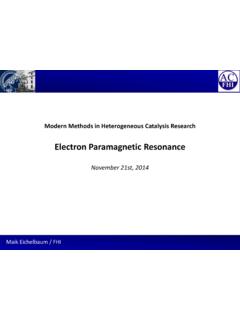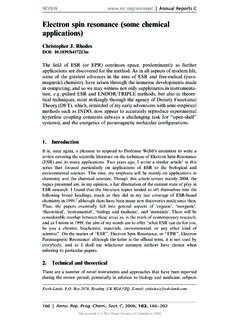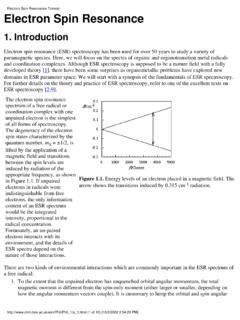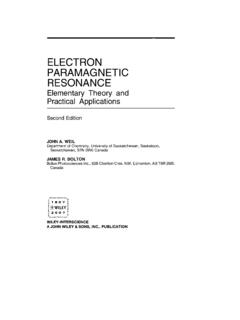Transcription of Electron Paramagnetic Resonance: Hyperfine Interactions
1 Electron Paramagnetic resonance : Hyperfine InteractionsChem 634 T. Hughbanks1 Reading Drago s Physical Methods for Chemists is still a good text for this section; it s available by download (zipped, password protected): For EPR: Chapters 9 and 13. Also good: Inorganic Electronic Structure and Spectroscopy, Vol. 1, Chapter 2 by Bencini and Gatteschi; and Vol. 2, Chapter 1 by Solomon and Hanson. Background references: Orton, Electron Paramagnetic resonance ; Abragam & Bleaney Electron Paramagnetic resonance of Transition Ions; Carrington & McLachlan, Introduction to Magnetic resonance ; Wertz & Bolton, Electron Spin is EPR (ESR)?
2 Electron Paramagnetic (Spin) resonance Applies to atoms and molecules with one or more unpaired electrons An applied magnetic field induces Zeeman splittings in spin states, and energy is absorbed from radiation when the frequency meets the resonance condition, h = E B H 1/ ~ 1 cm 1, = c/ ~ 1010 s 1 (microwave, GHz)3 Spectroscopy: The Big PictureEPR4 What information do we get from EPR? Chemists are mostly interested in two main pieces of information: g-values and Hyperfine couplings, though spin-relaxation information can also be important to more advanced practitioners. g-values: these are, in general, the structure-dependent ( , direction-dependent) proportionality constants that relate the Electron spin resonance energy to the direction of the applied magnetic field: h = gx,y,z BH.
3 The direction-dependence is determined by electronic structure. Hyperfine coupling: arise from Interactions between magnetic nuclei and the Electron spin and give information about the delocalization of the unpaired 5 What background do we need? We need an understanding of the magnetic properties of atoms and/or open-shell ions. In particular, we will need to understand the role of spin-orbit coupling, which is essential for understanding g-value anisotropy. Quantum mechanical tools: manipulation of angular momentum operators and understanding of how perturbation theory works. Basic ideas from MO theory and ligand field theory must be Aspects EPR performed at fixed frequency ( , field is varied).
4 Some common frequencies: X-band: ~ GHz, ( 109 s 1; ~ 3 cm); typical required field is ~ 3400 G = T - most common (h /ge B = G for = GHz) K-band: ~ 24 GHz ( 1010 s 1; ~ 1 cm); typical required field is ~ 8600 G = T - less common (h /ge B = G for = GHz) Q-band : ~ 35 GHz ( 1010 s 1; ~ cm); typical required field is ~ 12500 G = T (h /ge B = G for = GHz) Solvents: generally avoid water, alcohols, high dielectric constants (why?)7 Experimental Aspects Form of samples: Gases, liquids, solids, crystals, frozen solutions Glasses are best for solution samples measured below solvent freezing points because they give homogeneity, whereas solutions have cracks and frozen crystallites and scatter radiation Note: glasses can form with pure solvents or mixtures.
5 Unsymmetrical molecules have a greater tendency to form glasses. ( , cyclohexane crystallizes, methylcyclohexane tends to form glasses). H-bonding promotes Aspects Containers: Pure silica ( quartz ), not Pyrex (borosilicate glass); the latter absorbs microwaves to too great an extent Constant, homogeneous magnetic fields. Microwave generator (klystron) - sets up a standing wave, for which the frequency is fixed by the geometry of the cavity. To improve the S/N ratio (reduce the effect of 1/f noise), the field is generally modulated (100-200 kHz) and detected with a lock-in detector (amplifier). Phase-sensitive detection gives a true differential of line shapes.
6 For this reason, EPR spectra are normally displayed as derivatives this is actually convenient since it accentuates features of the absorption in which we are interested Experiment EPR: Fixed microwave frequency, sweep the field In NMR, frequencies are varied at fixed fields The power absorbed is measured as a function of field:Modulated Field H(t) = Hocos( t); where H=field t = some time constant and cos( t) = modulation frequencyNSh KLYSTRONMICROWAVEGENERATORMODULATEDPOWER SUPPLYMAGNETThe field is modulated to improve the S/N ratioSTANDINGMICROWAVE 10H-atom Spin Hamiltonian 1st term: electronic Zeeman 2nd term: nuclear Zeeman 3rd term: Fermi Contact Hyperfine (isotropic) magnitude depends on the Electron density of the unpaired Electron on the nucleus, (0).
7 HSpin=ge BH S gN NH I+aS Ia=8 3ge BgN N (0)2ge= ; gH= B=e!2mec= 10 21 10 24 J/T N=e!2mpc= 10 24 10 27 J/T ** This is the nuclear magneton - a constant that is not nucleus specific and is not the nuclear moment symbol used by MHz= 10 18 10 25 J (0)2= electrons/ 311 Electronic Zeeman interaction for H-atom If a hydrogen atom is placed in a magnetic field, H = Hz z, the Electron s energy will depend on its mS value. The Zeeman interaction between the applied field and the magnetic moment of the Electron is illustrated as: H ge BHge= mS= 12 mS=12 Nuclear spin neglected!12H-atom Spin Energies| e N | e N | e N | e N | e N | e N | e N | e N Electronic ZeemanNuclear Zeeman1st-order Hyperfine ge BH12ge BH12| e | e ge BH SgN NH12 gN NH12 gN NH12gN NH12 gN NH Ia14 a14| e N | e N | e N | e N a14a14+aS I2nd-order hyperfineturns on mixing!
8 A(SxIx+SyIy)=12a(S+I +S I+)aSzIz13H-atom Spectrum Hhv1=hv2E( e N) E( e N)=E( e N) E( e N)12ge BH1 12gN NH1+a4 12ge BH1 12gN NH1 a4 =12ge BH2+12gN NH2 a4 12ge BH2+12gN NH2+a4 (neglects 2nd-order Hyperfine )ge BH1+a2=ge BH2 a2 H1 H2!age B= G~1420 MHz14 Zero-field H-atomaSiI=a(SxIx+SyIy+SzIz)=a(12(S+I +S I+)+SzIz)aSiI e N=a12()12() e N=14a e NaSiI e N=a 12() 12() e N=14a e NaSiI12 e N e N() =a(12(S+I +S I+)+SzIz)12 e N e N() =12a(S+I +S I+)12 e N e N() +a12() 12()12 e N e N() 12a12 e N e N() 14a12 e N e N() for +: =14a12 e N+ e N() for : = 34a12 e N e N() 15 Exact H-atom Spin Hamiltonian e N e N e N e N e N e N e N e N12 e N()+14a E000012 e+ N() 14a E12a0012a 12 e+ N() 14a E0000 12 e N()+14a E where e=ge BH and N=gN NHSolutions:E=+14a 12 e N()E= 14a a2 2+ e+ N2 2from: Carrington & McLachlan, Introduction to Magnetic Resonance16H-atom EPR; variable fieldfrom: Carrington & McLachlan, Introduction to Magnetic Resonance17H-atom EPR.
9 Variable fieldfrom: Carrington & McLachlan, Introduction to Magnetic Resonance18most EPR measurements are from: Carrington & McLachlan, Introduction to Magnetic Resonance19A Note on units of energy Three different units of energy (none of them really are energy !) are used in EPR: cm 1 (1/ ), GHz or Hz or MHz ( ), and gauss (G). The conversions are done as follows: cm 1 c ( 1010 cm/s) Hz or cm 1 GHz Hz h/ge B ( 10-7 G-s) G or MHz G or cm 1 10697 G The conversion to gauss yields the field necessary to induce an equivalent Zeeman splitting for a free Electron . Example: a zero field splitting parameter of cm 1 could also be reported as GHz or 1082 radical splitting diagram The four transitions for the methyl radical.
10 +mI states are lowest for ms = 1/2 and the mI state lowest for ms = 1/2, from the I S Drago, Physical - Fig. 9-7 radical splitting diagram The four transitions for the methyl radical. +mI states are lowest for ms = 1/2 and the mI state lowest for ms = 1/2, from the I S to reflect the constant-frequency experimental +3/2MI=+1/2MI= 1/2MI= 3/2MI=+3/2MI=+1/2MI= 1/2MI= 3/222 Methyl radical Spectrum The four transitions for the methyl radical. +mI states are lowest for ms = 1/2 and the mI state lowest for ms = 1/2, from the I S Radicals OO aH=Q H ; Q! G24 ESR Spectrum: Naphthalide Anion 25 ESR Spectrum: Naphthalide Aniona = MHza = MHz~ G~ G26 Naphthalide Anion - ( ) ( )Numbers are coefficients from ESR (H ckel)2728 Nuclei with I > 1/2 A nucleus with spin I splits the Electron resonance into 2I + 1 peaks.


